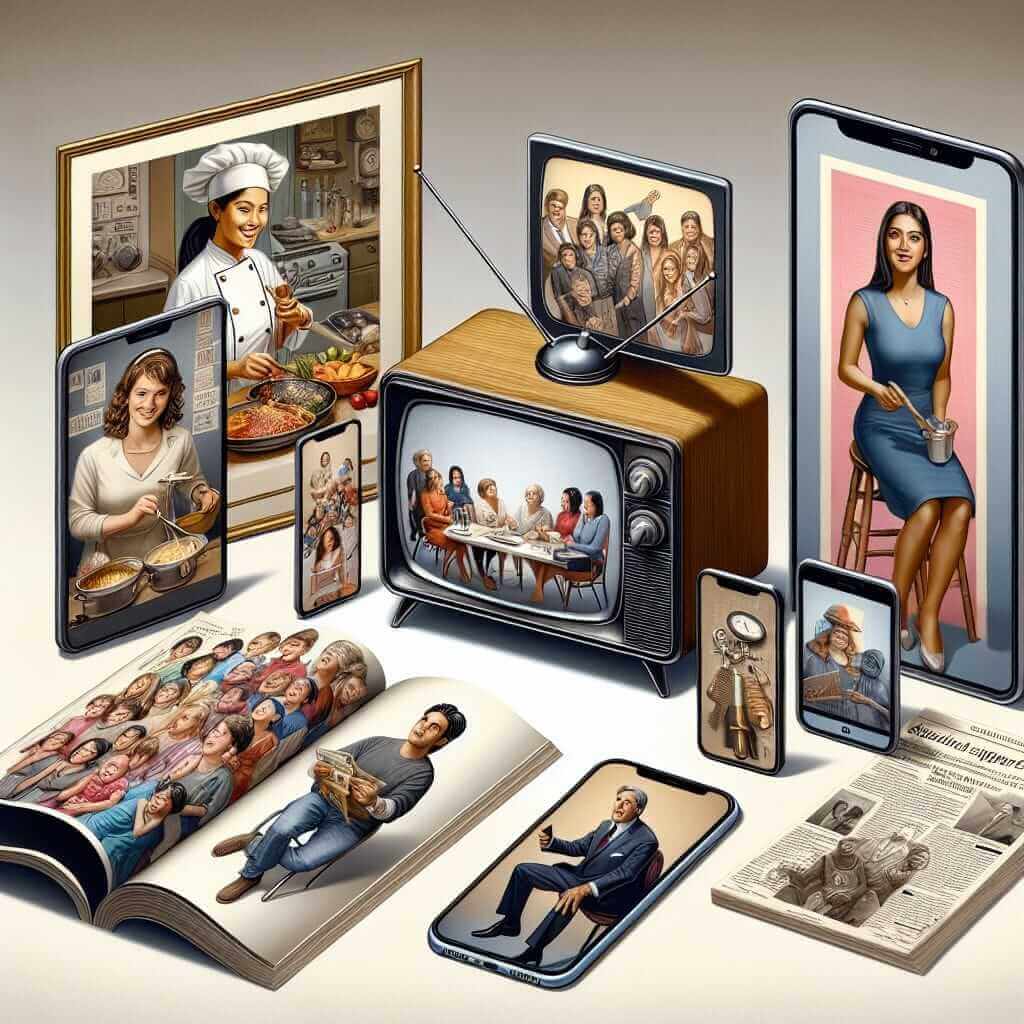Understanding the impact of media representation on gender roles is a crucial topic in modern society. The IELTS Reading section often includes passages that test candidates on various subjects, including social issues, cultural studies, and media studies. With the growing attention to gender equality, it’s plausible to expect related topics to appear in future tests. This makes preparing for such topics not only beneficial for exam purposes but also for broader social awareness.
Reading Passage (Medium Text)
The Role of Media in Shaping Gender Roles
Over the past few decades, media representation has played a significant part in forming and reinforcing gender roles in society. Television shows, films, advertisements, video games, and social media all contribute to the public’s perception of what it means to be male or female. This representation often reflects and reinforces traditional gender roles, though it can also challenge and change them.
Historically, media has portrayed men and women in ways that reflect stereotypical traits and roles. Men are often depicted as assertive, dominant, and career-oriented, whereas women are more likely to be shown in nurturing roles, focused on family and appearance. Such portrayals can limit the perceived potential and choices of individuals by confining them to societal expectations based on gender.
However, there has been notable progress in media representations of gender roles. Increasingly, media creators are aware of the impact their content has and are striving to promote gender equality and diversity. This shift is evident in the portrayal of women in leadership roles, men engaging in caregiving, and the inclusion of non-binary characters.
Research indicates that media can influence attitudes and behaviors related to gender. Young audiences, in particular, are susceptible to adopting the gender norms portrayed in media. As such, the content they consume can either reinforce outdated stereotypes or encourage more progressive views on gender.
Changes in media representation can impact society profoundly. For instance, more balanced representations of gender can foster greater equality in the workplace, education, and personal relationships. Media holds the power not only to reflect societal values but also to shape and transform them.
Nonetheless, challenges remain. Despite improvements, many media still perpetuate harmful stereotypes and underrepresentation of genders. It is crucial to continue advocating for more equitable and varied portrayals to ensure media helps build a more inclusive society.
Questions
Multiple Choice
- According to the passage, how has media historically portrayed men and women?
- A. Equally, without any stereotypes
- B. Reflecting traditional gender roles
- C. Challenging traditional gender norms
- D. Without focusing on gender aspects
Identifying Information (True/False/Not Given)
- The passage states that social media does not influence gender roles.
- A. True
- B. False
- C. Not Given
Matching Headings
- Match the following headings to the paragraphs:
- i) Progress in Media Representation
- ii) Historical Views on Gender in Media
- iii) Issues with Contemporary Media Portrayals
- iv) Media’s Societal Impact on Gender Perception
Sentence Completion
- Media holds the power to both and societal values.
Summary Completion
- Complete the summary using words from the passage:
Media representation has evolved over the years. Traditionally, men were shown as , while women were depicted in roles. However, modern media is increasingly portraying and perspectives on gender.
Answer Keys and Explanations
-
B. Reflecting traditional gender roles
Explanation: The passage mentions that men are often depicted as assertive, dominant, and career-oriented, and women in nurturing roles, reflecting traditional stereotypes. -
B. False
Explanation: The passage suggests social media, among other media forms, influences public perception of gender roles. -
i) Progress in Media Representation – Paragraph 3
ii) Historical Views on Gender in Media – Paragraph 2
iii) Issues with Contemporary Media Portrayals – Paragraph 6
iv) Media’s Societal Impact on Gender Perception – Paragraph 4 -
reflect and shape
Explanation: The passage notes that media holds the power to reflect and shape societal values. -
assertive; nurturing; equality; diverse
Explanation: The summary completion is drawn directly from the descriptive sentences in the passage about traditional and evolving media portrayals of gender.
Common Mistakes to Avoid
- Misinterpreting the tone: Candidates should identify whether the passage is descriptive, analytical, or critical.
- Ignoring signal words: Words such as ‘however,’ ‘although,’ and ‘despite’ can significantly affect the meaning of sentences.
- Overlooking specific details: Pay attention to the details that support the overall ideas, as questions often focus on these elements.
Vocabulary
- Assertive (adj) /əˈsɜːrtɪv/: Confidently self-assured in stating one’s views or opinions.
- Nurturing (adj) /ˈnɜːrʧərɪŋ/: Providing care and attention to help someone or something grow and develop.
- Reinforce (v) /ˌriːɪnˈfɔːrs/: Strengthen or support an idea or habit.
- Underrepresentation (n) /ˌʌndərˌrɛprɪzɛnˈteɪʃən/: Insufficient or disproportionately low representation, often of minority groups.
Grammar Focus
The Passive Voice
Usage: Emphasizes the action being performed rather than the subject performing the action.
Formula:
- Present Simple: is/am/are + past participle
- Past Simple: was/were + past participle
Example:
- The media is shaped by societal norms.
- Gender roles were reinforced by traditional media portrayals.
Tips for Improving Reading Score
- Active Reading: Engage with the text by asking questions and summarizing paragraphs.
- Time Management: Practice answering sample questions under timed conditions.
- Vocabulary Building: Regularly learn and review new words relevant to common IELTS topics.
- Practice Tests: Take full-length practice tests to build stamina and identify areas needing improvement.

By preparing rigorously and understanding the dynamics of media representation on gender roles, candidates can enhance their IELTS Reading performance and gain valuable insights into a pertinent social issue.